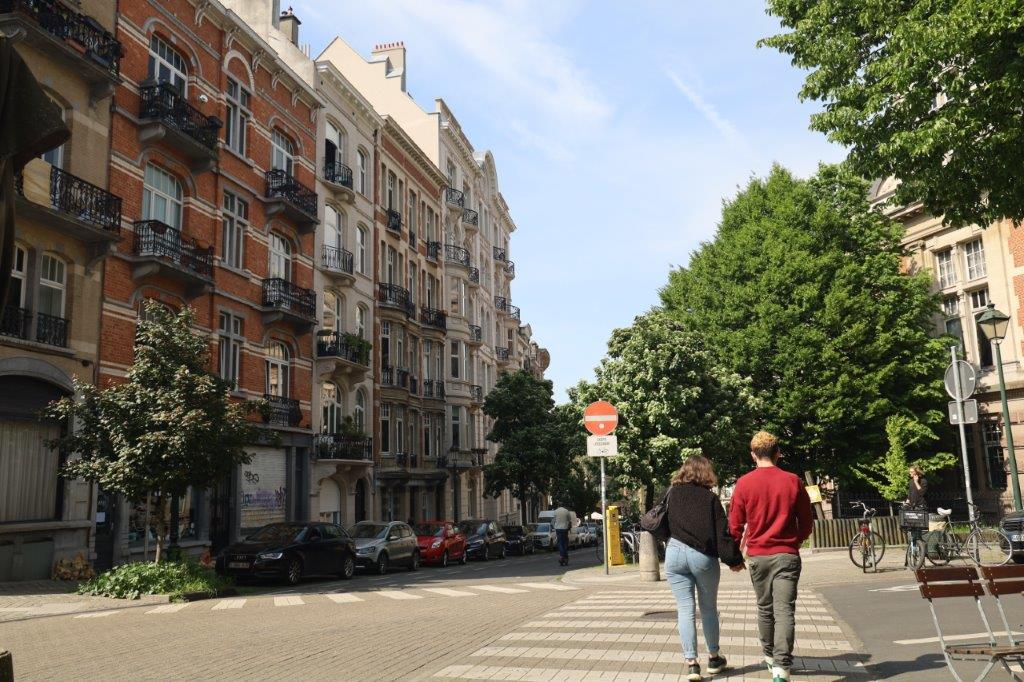Brussels according to François Schuiten: Visit to my favorite Brussels beer café at Moeder Lambiek (AGAIN)
This blogpost is a bit of an intermezzo and not a real citywalk. It is what I decided to do in the late afternoon and evening.
In almost all my Brussels visits (and there have been a lot), The Wandelgek visited Belgian beer café Moeder Lambiek, which is specialized in Lambic style beers (later more about that). So after his 2nd Brussels walk, The Wandelgek decided to visit them again and taste and enjoy some Belgian specialty beers.
From tube station Louiza/Louisa he took the metro toward Halle port / Hallepoort where he changed to another line and took the metro to Horta station in the municipality of Saint Gilles / Sint Gilles …
THE METRO STATION ‘HALLE PORTE’ IN BRUSSELS
This station is named after an old city gate which once stood here. The Wandelgek visited its remains and the prison years before.
 François Schuiten’s take on the Hallepoort:
François Schuiten’s take on the Hallepoort:
At Hallepoort he made a 1st stop and went searching for the famous escalator roof designed by François Schuiten and named Le Passage Inconnu (The Unknown Passage), containing loads of elements from his Cités Obscures books, like e.g. trolley line number 81, which appears in several of his books.
1st there was the artwork after arrival:
One of the most recently discovered Passage Points:
A recently discovered Passage Point is the Halle Gate metro station in Brussels. The word “gate”, the dark central tower, and the events not far away during the suddenly halted construction of the metro line under Place Louise all suggest that the spot could indeed lead to Brüsel.
The station is often kept in a state of disrepair.
Nothing unusual has ever been observed in the station itself, and the intrusive red tiles are in no way reminiscent of the Obscure Cities. However, from three tympanums emerge old trams resembling the carriages seen in the cities of Brüsel. You may remember the trams that were scrapped in the middle of construction, bricked up, and flooded. Their appearance here in Brussels further demonstrates the close ties between the two cities.
Next there was the pedestrian tunnel:
Last there was the artwork before leaving again …
This is the moment to consider the role of tram 81, which, for inexplicable reasons, returned regularly. It was so ubiquitous in the streets of Brüsel that some believed, quite wrongly, that this line was the only one to cross the city. Others claim that the preference for this tram has numerological reasons: 8 plus 1 equals 9, they explain, and 81 is itself the square of 9. But this pun on the word “neuf,” which means both “nine” and “new,” so that the tram would hold a “new promise,” has not led to any new insights.
The train passed the station of Parvis the St. Gilles, indicating that the municipality of St. Gilles had been entered. Brussels is a city which is built up out of 19 municipalities…
At Horta station, The Wandelgek left the metro. Horta, the great architect and interior designer who invented the Art Nouveau, and Brussels is the capital of the Art Nouveau.
If you like to see more of that, than please check the photography of this earlier blogpost about Brussels in 2009, which is stuffed with Art Nouveau photography including a visit to the home of Horta:
Saint Gilles
Saint-Gilles (Dutch: Sint-Gillis) is a town and municipality in the Brussels-Capital Region. Formerly known as Sint-Gillis-Obbrussel (French: Sint-Gillis-lez-Brussel), the municipality has over 49,000 inhabitants.
Clockwise, Saint-Gilles is nestled between Anderlecht, Brussels City, Ixelles, and Forest. In the northeast corner, the municipality still has a small enclave of several plots of land on the opposite side of Brussels’ southern extension, Avenue Louise. The far west is occupied by SNCB-NMBS land, including the Brussels-South station (which The Wandelgek is visiting in his next upcoming blogpost) with its high-speed train terminal.
After exiting the small exit building, you’re facing a busy street, but you do not want to go there. Turn around and walk around the exit building to the rearside and in between two high building toward another busy street, the Paul Dejaerlaan.
Turn left and follow the street until you see the large city hall of St. Gilles.
Cross the street and turn right and immediately left, walking to the rear of the city hall. Cross the Savoiestraat, after reaching the rear right corner of the city hall.
Moeder Lambiek is at the other side of the street.
Beneath is Moeder Lambic …
It has been a warm sunny day so The Wandelgek started at the terrace with some light refreshing types of beers …
… and of course some delicious Belgian cheese to accompany those beers …
Meanwhile he was reading more about Brussels, about François Schuiten and about what he could be doing the next day …
The plan for that was to try and find an above ground section of the River Zenne, which had been tunneled in almost all of Brussels.
The Wandelgek was now trying some heavier beers …
It began to get dark …
… and The Wandelgek moved inside, where he was pleased to hear that similar music as 10 years ago was still played, like e.g. Fela Kuti and Lou Reed …
In the cellar were the more expensive and rare bottles of real Lambic beers …
After some drinks, The Wandelgek walked back to the Hotel de Ville of St. Gilles, which was beautifully lit ….
Next The Wandelgek returned to the Horta tube station, returned to Hallepoort tube station on the ring and changed metro train to Madoux tube station from where he returned to the Place de la Liberté where he sat on the outdoor terrace and had a another beer (note that this beer is from “Brasserie de la Senne” and Senne is French for Zenne) …
… before returning to his hotel, just around the corner. It was a warm spring night.
Read more of my wanderings through Brussels in the footsteps of François Schuiten in my previous and upcoming blogposts.




































































































